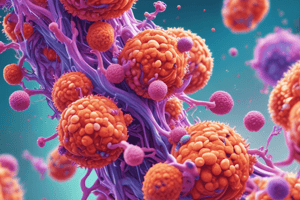Podcast
Questions and Answers
The ______ is responsible for differentiating T helper and T cytotoxic cells.
The ______ is responsible for differentiating T helper and T cytotoxic cells.
thymus
The structure and function of the T and B cells of the ______ system are crucial for immune response.
The structure and function of the T and B cells of the ______ system are crucial for immune response.
immune
Innate immunity is also known as ______ immunity, providing immediate defense.
Innate immunity is also known as ______ immunity, providing immediate defense.
inherent
Granulocytes are a type of ______ that play a role in immune responses.
Granulocytes are a type of ______ that play a role in immune responses.
The ______ locus is important for the regulation of immune responses in humans.
The ______ locus is important for the regulation of immune responses in humans.
Study Notes
Structure and Function of T and B Cells
- T cells and B cells are crucial components of the adaptive immune system.
- T cells are responsible for cell-mediated immunity, while B cells are responsible for humoral immunity.
- T cells develop in the thymus and include subtypes such as helper T cells and cytotoxic T cells.
- B cells mature in bone marrow and produce antibodies to neutralize pathogens.
Differentiate T Helper and T Cytotoxic Cells
- T helper cells (CD4+) assist other immune cells by releasing cytokines.
- T cytotoxic cells (CD8+) directly kill infected or cancerous cells.
- T helper cells activate B cells and enhance the activity of macrophages.
Structure and Function of Granulocytes
- Granulocytes are a type of white blood cell with granules in their cytoplasm.
- Three main types: neutrophils (phagocytize pathogens), eosinophils (combat parasites), and basophils (release histamine).
- Essential for the inflammatory response and defense against infections.
Structure and Function of Thymus
- The thymus is a lymphoid organ located in the upper chest.
- It provides a site for T cell maturation and differentiation.
- Produces thymosin, which stimulates T cell development.
Bone Marrow
- Bone marrow is the primary site of hematopoiesis (formation of blood cells).
- Contains stem cells that differentiate into red blood cells, white blood cells, and platelets.
- B cells mature here before entering the bloodstream.
Lymph Node
- Lymph nodes are small, bean-shaped structures that filter lymph fluid.
- Act as hubs for immune cell activation, proliferation, and response to pathogens.
- Contain B cells, T cells, and macrophages for monitoring and fighting infection.
Spleen
- The spleen filters blood and helps mount immune responses.
- Contains red pulp (removes old or damaged red blood cells) and white pulp (rich in lymphocytes).
- Acts as a site for antigen presentation and T and B cell activation.
MALT (Mucosa-Associated Lymphoid Tissue)
- MALT includes lymphoid tissues associated with mucosal surfaces (e.g., gut, respiratory tract).
- Responsible for generating immune responses to pathogens encountered through mucosal surfaces.
- Components include Peyer’s patches in the intestine and tonsils.
Inherent or Innate Immunity
- Innate immunity is the body's first line of defense against pathogens.
- Includes physical barriers (skin, mucous membranes) and immune cells (phagocytes, natural killer cells).
- Provides immediate but non-specific responses to infection.
Acquired Immunity
- Acquired immunity develops after exposure to a specific pathogen.
- Characterized by the formation of memory cells and a stronger response upon re-exposure.
- Can be acquired naturally (infection) or artificially (vaccination).
Physical and Chemical Barriers
- Physical barriers include skin and mucosal membranes that prevent pathogen entry.
- Chemical barriers include secretions such as saliva, gastric acid, and antimicrobial peptides.
- Both types work together to limit pathogen access to the body.
Inflammation
- Inflammation is a protective response to tissue injury or infection.
- Involves the release of signaling molecules that recruit immune cells to the site of damage.
- Symptoms include redness, heat, swelling, and pain.
Phagocytosis
- Phagocytosis is a process by which certain immune cells engulf and digest pathogens.
- Key phagocytic cells include macrophages and neutrophils.
- Plays a critical role in clearing infections and debris from tissues.
Types of Immunity
- Two major types: innate immunity (non-specific, immediate) and adaptive immunity (specific, delayed).
- Adaptive immunity further divides into humoral immunity (B cells producing antibodies) and cell-mediated immunity (T cells).
Humoral Immunity
- Mediated by B cells and involves the production of antibodies specific to antigens.
- Key in defending against extracellular pathogens and toxins.
- Antibodies neutralize toxins and enhance the opsonization and clearance of pathogens.
Cell Mediated Immunity
- Involves T cells, particularly cytotoxic T cells that destroy infected host cells.
- Critical for eliminating intracellular pathogens and cancer cells.
- Also involves helper T cells, which coordinate the immune response.
Compare the Two Classes of MHC
- Major Histocompatibility Complex (MHC) Class I presents antigens to CD8+ T cells and is found on all nucleated cells.
- MHC Class II presents antigens to CD4+ T cells and is expressed on professional antigen-presenting cells (e.g., macrophages, dendritic cells).
Explain the HLA Locus
- The Human Leukocyte Antigen (HLA) locus is a complex of genes on chromosome 6.
- Includes genes for MHC molecules critical for immune system function.
- Plays a significant role in the body’s ability to recognize self versus non-self.
Significance of MHC in Organ Transplantation
- MHC compatibility is crucial for successful organ transplantation to minimize rejection.
- Donor and recipient MHC must be matched to reduce the risk of immune response against the transplanted organ.
- HLA typing prior to transplantation helps find suitable matches.
Studying That Suits You
Use AI to generate personalized quizzes and flashcards to suit your learning preferences.
Description
Test your knowledge on immunology topics covered in Semester V at Sardar Patel College. This quiz includes questions on T and B cells, different types of immune cells, and key components of the immune system such as the thymus, spleen, and lymph nodes. Challenge yourself to differentiate between innate and acquired immunity.




